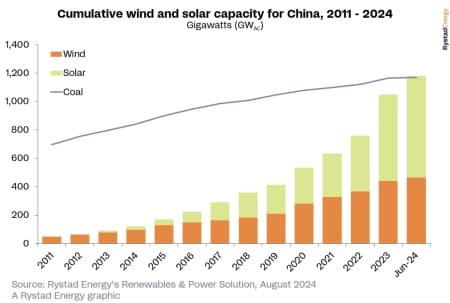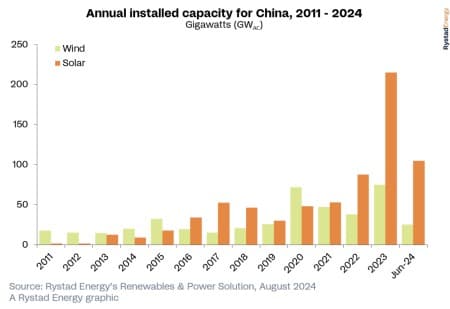China is undergoing a transformative shift in its energy landscape. For the first time ever, wind and solar energy have as of June this year collectively eclipsed coal in capacity, according to the latest data from the country’s National Energy Administration (NEA). Rystad Energy’s analysis forecasts that by 2026, solar power alone will surpass coal as China's primary energy source, with a cumulative capacity exceeding 1.38 terawatts (TW)—150 gigawatts (GW) more than coal.
This shift stems from a growing emphasis on cleaner energy sources and a move away from fossil fuels for the nation. Despite coal's early advantage, with around 50 GW of annual installations before 2016, China has made substantial investments to expand its renewable energy infrastructure. Since 2020, annual installations of wind and solar energy have consistently exceeded 100 GW, three to four times the capacity additions for coal. This momentum has only gathered pace since then, with last year seeing China set a record with 293 GW of wind and solar installations, bolstered by gigawatt-scale renewable hub projects from the NEA’s first and second batches connected to the country’s grid.
China's coal power sector is moving in the opposite direction. Last year, approximately 40 GW of coal power was added, but this figure plummeted to 8 GW in the first half of 2024, according to our estimates. Despite the expansion of renewable energy under supportive policies, the government has implemented stricter restrictions on new coal projects to meet carbon reduction goals. Efforts are now focused on phasing out smaller coal plants, upgrading existing ones to reduce emissions and enforcing more stringent standards for new projects. As a result, the annual capacity addition gap between coal and clean energy has widened dramatically, reaching a 16-fold difference in the first half of 2024.
We're at a pivotal moment for both China and the global energy transition. With strong renewable energy project pipelines in place, the country is on track to shed its reputation as the world’s largest greenhouse gas emitter and power consumer. Solar energy will be central to this transformation, with advancements in supply chains, infrastructure and capacity additions set to surpass coal in future energy production. This shift could be a landmark achievement, potentially transforming China from a coal-dependent giant into a leader in clean energy
Simeng Deng, Senior Analyst, Rystad Energy

Wind power was introduced in China in the early 2000s as the country's first new energy source, and scaling in wind power capacity accelerated during the following decade. In 2011, the country had 17.6 GW of new onshore wind capacity installed. Wind installations grew steadily from 2011 to 2019, adding 15 GW to 30 GW of new capacity each year, with offshore wind developments coming into the country’s power mix since 2018. In 2020, there was a notable increase, with a record 71 GW of new installations, driven by the urgency to secure feed-in tariffs and subsidies before they were phased out by the nation. The rise was followed by an immediate fall, with installations then dipping for the next two years. However, wind capacity rebounded last year with 75 GW of new additions, fueled by accelerated project development to meet national targets for 2025. In the first half of this year, 25 GW of new capacity was added, with estimates from Rystad Energy predicting an additional 50 GW in the second half of the year.
Solar photovoltaic (PV) made a notable impact on China’s power mix starting in 2013 with 16 GW of capacity. Benefitting from significant cost reductions, higher annual installations grew to between 30 GW and 50 GW between 2016 and 2021. In the following year, China added 87 GW of PV, driven by accelerated development in large-scale projects and rooftop PV initiatives. Consequently, this resulted in a record 216 GW of new capacity recorded last year. With 105 GW added in the first half of this year, China is expected to exceed 230 GW in total new solar capacity for the year.

As China’s clean power capacity grows, it faces significant challenges, such as low utilization and intermittency. Addressing these issues requires substantial upgrades to grid infrastructure to enhance transmission flexibility and storage capabilities. Battery storage will also be crucial for maintaining grid reliability, ensuring that stability is preserved as clean energy expands to meet the needs of a growing population and broader national targets.
ADVERTISEMENT
More Top Reads From Oilprice.com:
- Traders Bet on $130 Oil as Middle East Tensions Spike
- Oil Prices Soar After Israel Kills Hamas Leader and Hezbollah Senior Commander
- Venezuela's Election Authority Declares Maduro Victor in Disputed Election


















This is a model to be followed worldwide. Instead of the militancy of Western green policies of accelerating energy transition at the expense of fossil fuels and calls by the IEA to halt immediately any new investments in oil and gas projects, China allows all energy resources to coexist together and work diligently to satisfy its energy needs. The bigger the share of solar and wind electricity the less coal and gas its needs.
However, China, India and other countries with sizeable coal reserves will never ever stop using coal since it provides the cheapest electricity and is a cornerstone of their energy security.
Global demand for coal will continue to rise well into the future albeit at a slightly decelerating rate because of the rise of solar and wind energy contribution to global electricity and governmental legislations.
Solar and wind energy is incapable on its own of satisfying the global demand for electricity because of their intermittent nature.
Dr Mamdouh G Salameh
International Oil Economist
Global Energy Expert